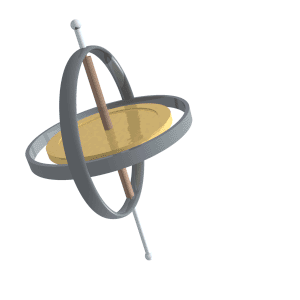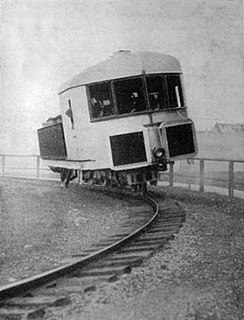Definitions
The term gyroscope as defined by "American Heritage Dictionary" is: "a device consisting of a spinning mass, typically a disc or wheel mounted, on a base so that its axis can turn freely in one or more directions and thereby maintain its orientation regardless of any movement of the base". The "base" of the gyro-stabilized head is the support system to which the head is attached, whether it is a crane, camera car or helicopter. The "base motion" must be eliminated from affecting the picture. How well that is achieved is called the "bandwidth" of the system.
A low bandwidth design will stop a percentage of low frequency motions from getting to the camera and shaking the image (i.e. rocking and rolling from a boat, sway from a camera crane).
A high bandwidth system will stop low and high frequency, or a large range of base motion, from getting to the camera (i.e. the vibration of a helicopter, the rapid shakes and bumps from a camera car, as well as the rocking and rolling of a boat and sway of a camera crane).
To remove the "angular base motion" is the most important job of the stabilized system. Angular disturbances are vibrations that are angular to the axis of the film plane. If the camera has an angular disturbance of 1° then the line of sight of the lens will sweep a large area in the camera frame, as the focal point of the lens may be a mile away and that 1° multiplied by a mile is a huge sweep in the camera frame.
The "Linear Base Motion", also called parallax error, is actually of little consequence to the Director of Photography and current world technology cannot completely remove it. Parallax error will cause the foreground to move in frame while the background is stationary.
Linear disturbances are vibrations that are perpendicular to the film plane, side-to-side and straight up and down movements. If the linear disturbance is 0.1 of an inch at the film plane then at the line of sight a mile away the lens will move only 0.1 of an inch. This phenomenon is not noticeable at the long end of the lens and only slightly negligible with short lenses when the subject is very close to the focal plane.
Every stabilized system, active or passive, whether high or low bandwidth design, eliminates only the angular or rotational movements and the linear disturbance (straight up and down or sideways) can only be minimized by a cushion between the base connection of the head/mount and its support. These are the springs or coils that are used at the connection between the standard Mitchell mounting and the stabilized head/mount. In some cases the cushion is built into the stabilized system.
Other terms that are used to describe a stabilization system are "active" or "passive" systems of stabilization.
Active systems are ones that utilize DC power, sensors, electronics and motors attached to gimbal rings to correct a "base" motion from affecting the camera. Examples of "active systems" range from the Nettmann System's Stab-C to the Geo Film's Libra Head.
Passive systems are purely mechanical and rely on the "balanced beam" phenomena. The 'beam' will resist a "base" motion from affecting the camera positioned at the end of it because of the inherent inertia of the balanced beam. Examples of passive systems are Tyler Middle and Major Mount, Advanced Camera Gyromaster and Steadicam.
The categories below are listed in order:
- Range of vibration bandwidth that the system can eliminate
- The quality of the stabilization design
- The range of cameras that can be used
TYPE 'A' (Fully Servoed Electronic Stabilization))
These systems are of a high bandwidth design and rely on complex electronic sensors, actuators and motors to correct the base motion from affecting the camera. They will remove almost all of the angular disturbances from the shot. All of the (A) systems utilize electronic control servo loops, are extremely fast acting (high bandwidth) and very adaptable to various camera/lens payloads. These systems can be used extensively on camera car, crane, or suspended cable systems as well as aerial helicopter work. These systems can stabilize almost any camera and lens combination imaginable, as they are open architecture i.e., the camera is not part of the system. The open architecture A systems are stabilizing platforms only. They will stabilize any film or video camera provided the center of gravity of the camera can be positioned inline with the inner gimbal axis. This is a very nice feature as any standard production camera or lens can be utilized to the delight of the DP or visual effects dept. These systems have a steerable roll feature where the roll axis can actually dutch while still stabilizing or can just keep the horizon level.
TYPE 'A-1' (Helicopter Ball Mounts)
- Closed architecture; limited camera selection
- Horizon leveling – roll 'dutch' not steerable
- Electro-mechanical gyroscopic technology
These systems are all remote controlled gyroscopic assisted stabilizing platforms. They utilize a series of spinning fly wheels and electronics to dampen the angular disturbances. They are mostly used for helicopter work but can also be used for camera car, crane, or suspended cable systems. The A-1 systems do not have steerability of the roll (dutch) axis, only horizon leveling. These systems as well as the (A), will eliminate almost all of the angular disturbances. The drawback is that the (A-1) systems are closed architecture systems. The DP can only utilize the offered one or two cameras and lens combinations, normally a Mitchell R35 camera and a 10:1 zoom lens.
TYPE 'B' (Electronically Stabilized Heads)
- Servoed electronic gyroscopic technology
These systems are of a low bandwidth design and rely on sensors, actuators and motors to correct the base motion from getting to the camera. They will remove a good percentage of the low frequency angular disturbances from the shot, but the high frequency jitter and shake will still get through to the lens. All of these systems are currently used for ground-based applications. All of the (B) systems utilize electronic control servo loops, and are adaptable to various camera/lens payloads as most are based on the typical remote head design. The camera is not integrated into the stabilization system, as in the (A-1) category, or the closed architecture systems of the (A) category.
TYPE 'C' (Helicopter side door mounts)
- Passive Stabilization (High inherent inertia)
- Open architecture
Stabilization qualities enhanced by placement of Kenyon gyros onto mount Helicopter mounts are based on the principle of a balanced beam that has its gimbal point (center of gravity) behind the operator's head. The gimbal point is the exact balance point of the roll, pitch and yaw. At the front of the balanced beam is the camera and camera control. At the back of the beam are the counterweights and batteries. The camera has an additional pan and tilt axis (yaw and pitch axis). These are balanced in their own right about the sub camera tilt axis of the balanced beam. This balanced beam in itself has a certain amount of inertia and will resist minimal angular disturbances coming up the gimbal mounting frame. However, in order to achieve a further degree of stabilization, Kenyon gyro modules are added. The Kenyon gyro module is an off-the-shelf motorized flywheel in a cage with one degree of freedom. When the spinning masses (flywheels) within the Kenyon gyro housing, are activated, they add an increased inertia (synthetic) to the overall system, which improves the mount's ability to absorb the base angular disturbances from reaching the camera. These helicopter mounts with or without Kenyon gyros, can work quite well if: the weather conditions are perfect; the helicopter has the minimum of low frequency vibration (blades have been 'tracked' correctly); and you have a "qualified movie pilot" in control of the ship. An operator can achieve good stability for medium focal length lenses with short duration shots at the longer end of the lens. The drawbacks of (C) systems are that the operator's physical strength is needed to position the camera while they are hanging out the side door of the helicopter. It is hard for the operator to maneuver the camera's line of site when they are following a subject. The Kenyon gyros will resist their camera positioning, as the gyro will consider it part of the angular base motion. Because of this interaction, the helicopter pilot must undertake most of the camera positioning; the operator will just point the camera at the subject, relying on the pilot for keeping the subject in frame.
TYPE 'C-1' (Horizontally balanced gimbal rings)
- Passive Stabilization (Low inherent inertia)
- Open architecture
Stabilization qualities enhanced by additional gravity seeking pendulous mass. These types of systems use a pendulous swinging mass assisted by motors to reduce angular disturbances. Originally designed to remove the extremely low frequency angular disturbances of the ocean's rolling motion, they are now being used to stabilize cameras and remote heads in certain applications.
TYPE 'D' (Horizon Lock Only systems)
- Single axis stabilization
- Closed architecture; limited camera selection.
These systems are simple three axis camera positioners with only the roll axis horizon stabilized. When the horizon compensation is turned on, the system will only hold the horizon in frame. This helps maintain the horizon when the head is mounted on a crane or vehicle. No other axis is gyro stabilized thereby allowing the full range of base motions to get to the camera and lens. [2]












